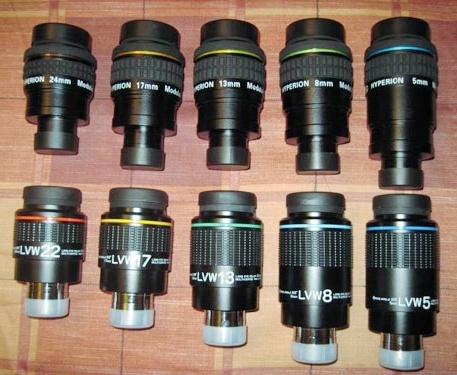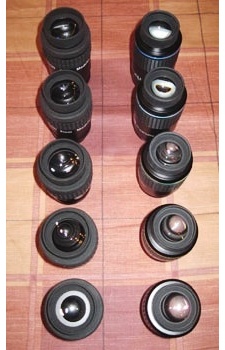For the past few weeks I’ve had the opportunity to compare a number of Baader Hyperion eyepieces with their equivalents from the Vixen LVW range. The Hyperions are made in China whereas the LVWs are of Japanese manufacture and retail for roughly twice as much as the Hyperions. I was loaned the 5mm, 8mm, 13mm, 17mm and 22/24mm focal lengths for this comparison (the 22mm is the longest focal length available in the 1.25” format LVW series).
First Impressions
Comparing the specifications, the Hyperions are stated to provide a consistent 20mm of eye relief across the range and an apparent field of view (AfoV) of 68 degrees. The LVWs match the Hyperions in eye relief but deliver a slightly smaller AfoV of 65 degrees. Both eyepiece ranges use good quality multi-coatings on all the air to glass surfaces, have blackened lens edges and carefully designed internal baffling to minimise light scatter and maximise contrast. Baader state that the Hyperions use 8 “low index” glass elements while Vixen state that Lanthanum glass is used in the 6-8 element LVWs.
The Baader Hyperions are described as being modular eyepieces and incorporate a number of thoughtful features and options which add much to their flexibility. This includes the Hyperion Fine Tuning Rings which can be used in various combinations to deliver a much wider range of effective focal lengths – a feature which works remarkably well. These rings do not work with the 24mm eyepiece.
There is quite a difference between the ranges when it comes to their packaging. The Vixen LVWs each come in a modest white box with just the basic information on its contents printed on it. The eyepiece itself is wrapped safely in a plastic bag, with some bubble wrap, and has top and bottom dust caps – nothing more. Baader has gone to town with the Hyperions with glossy printed boxes, outer and inner plastic bags with a small silica gel pack, a nice little leatherette drawstring pouch, top and bottom dust caps plus an additional dust cap to use depending if you use the eyepiece with it’s rubber eye cup raised of lowered.
Baader’s attention to detail is impressive but I suppose it must add to the production costs and, in practice, I reckon the pouch might be more trouble than it’s worth in the dark. It would protect the Hyperions well in between use though.
When you do get them unwrapped, the two ranges look rather similar:

The internal lens arrangements of these eyepieces result in the shorter focal lengths requiring the longest housings and compared to many designs these are large eyepieces. The Hyperions can be used in 2” mode if desired and weigh between 329 grams (24mm) and 417 grams (5mm). The LVWs weigh around 25% more across the range and this is noticeable as you pick them up and use them.
Both eyepiece ranges are finished to a high standard although Baader have used more, and chunkier, soft rubber surrounds and grips which I found very reassuring to hold with cold fingers. Vixen and Baader use screen printed lettering which does have the tendency to flake off over time, judging by used examples that I’ve seen for sale. The Hyperions are in an all-over black anodised finish while the LVWs have a smoother black finish but retain chrome barrels – a more traditional look and feel perhaps?
 From the top, the Hyperions (to the left) employ larger diameter eye lenses than the LVWs in all but the 24mm focal length (bottom left).
From the top, the Hyperions (to the left) employ larger diameter eye lenses than the LVWs in all but the 24mm focal length (bottom left).
Using The Eyepieces
As I was observing, switching between the eyepieces, certain characteristics did become evident which I’ll try and summarise at the end of these observing notes. I must also say that these are just my impressions, with my scopes under my observing conditions – “your mileage may vary” as the saying goes!.
I tried all the eyepieces from both ranges on a selection of astronomical objects over four viewing sessions and with varying viewing conditions. The scopes I used were an Orion Optics 10” f4.8 Newtonian, an Intes 6” f5.9 Maksutov-Newtonian and a Vixen 4” f6.5 ED refractor.
Objects observed included the Epsilon Lyrae (the “Double Double”), Polaris and companion, Iota Casseopea, M57 (the Ring Nebula), M27(the Dumbell Nebula), Vega, the double cluster in Perseus, galaxies M31, M32, M110 and M33, M15 globular cluster, Jupiter, Uranus, the Moon and the Pleiades cluster.
Both sets of eyepieces are more or less par-focal within their range. There is a few millimetres difference between their focal points so swapping between the brands requires a quarter turn or so of the focuser wheel to re-focus.
The slightly smaller field of view of the Vixen LVWs was barely, if at all, noticeable in actual use.
With the 10” f4.8 Newtonian, the Vixen LVWs were noticeably better corrected at the edge of the field of view with stars showing as pinpoints almost right to the edge. While the Hyperions appeared sharp across the central area of the field, they did show astigmatic stars in the outer 20% of the field although this was not a pronounced as some less expensive wide field eyepieces that I have tried. It is also more noticeable at lower magnifications. When used in the f5.9 Maksutov-Newtonian the astigmatism was significantly reduced and with the 102mm f6.5 refractor it was hardly noticeable.
Views of above deep sky objects were very similar in both eyepiece ranges across the central 80% of the field of view with their light throughput seeming equal to my eyes.
The number of stars visible amidst the misty glow of M27 with 17mm focal lengths and above were the same in both eyepiece types. The extent of nebulosity shown and the contrast within it looked virtually identical as well.
The double cluster in Perseus was excellent and sharp in both eyepiece types. Stars towards the field edge were better defined in LVW as noted earlier.
The core regions of M31 as well as M32 and M110 all fit into the FoV of the 22mm LVW and 24mm Hyperion in my 1200mm focal length scope. They just spill over the edge of 17mm focal lengths in both brands. Again the field of view differences between the brands was not noticeable during viewing.
With the 10” Newtonian, the globular cluster M15 resolved into 1000’s of tiny star points with a condensed core from 13mm and upwards in both ranges.
Good detail on Jupiter at 5mm and 8mm was visible with both eyepiece brands. Light scatter is possibly just a tiny bit better controlled in the LVWs compared to their Hyperion cousins – the sky around the planet seemed a little darker with the Vixens. Both brands 5mm versions allowed the Great Red Spot to be seen with the 4” refractor. The 5mm LVW showed a faint “ghost” image of Jupiter amongst the Galilean moons that was not seen with the equivalent Hyperions.
Rising in the early hours, the Pleiades looked very nice at low power but edge performance of the 24mm Hyperion, in the fast Newtonian, started to get a little distracting. By contrast the stars were almost sharp to the edge with the LVW 22mm in this scope.
The A, B and C components of the triple star Iota in Casseopia, were well split with 5mm and 8mm eyepieces (both brands) when used with my 4” f6.5 ED refractor. The closer pair were “suggested” rather than split with both the 13mms.
The double cluster dominated the field with the 24/22mm’s. The LVW is sharp to the edge at f5.9 while the Hyperion was 85% sharp with the remaining 15% showing some astigmatism but this was not too distracting.
Finally I observed a 90% illuminated Moon with the 6” Maksutov-Newtonian with the 5mm and 8mm focal length Hyperions and LVWs. Details seen of lunar features were very similar in both eyepiece types. The Vixen LVWs do seem slightly better at controlling glare and the sky looked blacker adjacent to the lunar limb as it had with Jupiter.
During this session I noticed that the eyepiece field edge was defined like a knife edge with all the LVWs but slightly less well defined with the Hyperions (although this is a minor factor).
Summary
Baader Hyperion
A thoughtfully designed and well made range, I felt that the Hyperions were very nice eyepieces to own and use. They are a significant step up from the eyepieces supplied with scopes and standard quality plossls and, with their carefully thought out packaging, seem to me to deliver good value for their approx £90 retail price.
The modular options such as the fine tuning rings really do work and add flexibility and further value to the range, with the exception of the 24mm which cannot be used with the FT rings. They (like the Vixen’s) are large eyepieces but their extensive use of rubber makes their handling secure and reassuring.
Optically they are very comfortable to use and seem able to deliver excellent quality views of a wide range of astronomical objects. In scopes slower than f6 or so I think they perform at their best. In faster scopes than this the edge of field astigmatism could prove distracting when viewing extended objects but this will not bother everybody by any means. While their control of light scatter around bright objects does not appear to be quite as good as the Vixens, by others standards, they are still pretty decent in this respect.
Vixen LVW
The LVWs are rather understated compared directly to the Hyperions but are clearly high quality items as soon as you pick them up. With the exception of the printing on the barrels, which I know does flake in time, the LVWs finish is impeccable. They have noticeably more “heft” to them than the Hyperions do and their weight may cause some scope balance issues.
Optically I felt that, while very similar on many occasions to the Hyperions, the LVWs show their quality at the field edges and in really effective suppression of stray light which suggests a really well balanced blend of internal baffling, glass and coating quality. At their best they reminded me of the views I have had through Pentax XW eyepieces and Tele Vue Panoptics. The 5mm LVW did seem to have a slight “ghost” when viewing Jupiter.
The Vixen LVW’s cost twice as much as the Baader Hyperion’s and, to me at least, they do deliver slightly superior performance in some areas as mentioned above. I won’t attempt to pass an opinion on whether or not these differences are worth the additional cost as that must be a personal decision. Owners of fast scopes will derive more benefit from the higher investment in my opinion although the Vixen pricing does take them into the territory of some other serious rivals.
Many thanks to Steve and James at First Light Optics for trusting me with these 10 very nice pieces of kit for a few weeks.
John Huntley





very informTive but still havent seen the light